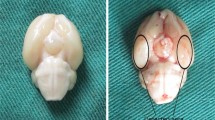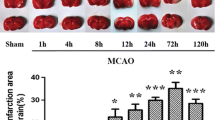Abstract
Synapses, the junctions between nerve cells through which they communicate, are formed by the coordinated assembly and tight attachment of pre- and postsynaptic specializations. Synaptic cell adhesion molecule 1 (SynCAM 1) has been proved to be an important factor for synapse function and behavior cognition. The current research aimed to investigate the expression of the SynCAM 1 in the brain after experimental subarachnoid hemorrhage (SAH) in rats. A total of 42 rats were randomly divided into seven groups: control group, sham group, day 1, day 3, day 5, day 7, and day 14 groups. Day 1, day 3, day 5, day 7, and day 14 groups were all SAH groups in which the rats were killed on days 1, 3, 5, 7, and 14, respectively. The rat SAH model was induced by injection of 0.3 ml fresh arterial, non-heparinized blood into the prechiasmatic cistern in 20 s. Immunostaining and immunoblotting experiments were performed to detect the expression of SynCAM 1 protein. The clinical behavior scale was measured on day 14 after SAH. The expression of SynCAM 1 protein was decreased remarkably in SAH groups compared with the sham group. The down-regulated expression of SynCAM 1 was detected after SAH and the low ebb was on days 1–3. The immunohistochemical staining demonstrated expression of SynCAM 1 was present mainly in the neurons in all of the three different regions such as cortex, hippocampus, and cerebellum. The clinical behavior scale was significantly decreased compared with sham rats. Our results indicate that SynCAM 1 expression is down-regulated in the brain after experimental SAH. These finding suggests that decreased SynCAM 1 expression may facilitate the development of cognitive dysfunction after SAH.





Similar content being viewed by others
References
Athar MK, Levine JM (2012) Treatment options for cerebral vasospasm in aneurysmal subarachnoid hemorrhage. Neurotherapeutics 9(1):37–43
Kosty J, Macyszyn L, Lai K, McCroskery J, Park HR, Stein SC (2012) Relating quality of life to Glasgow outcome scale health states. J Neurotrauma 29(6):1322–1327
McKenna P, Willison JR, Phil B, Lowe D, Neil-Dwyer G (1989) Cognitive outcome and quality of life one year after subarachnoid haemorrhage. Neurosurgery 24(3):361–367
Ogden JA, Mee EW, Henning M (1993) A prospective study of impairment of cognition and memory and recovery after subarachnoid hemorrhage. Neurosurgery 33(6):572–587
Stabell KE, Magnaes B (1997) Neuropsychological course after surgery for intracranial aneurysms. A prospective study and a critical review. Scan J Psychol 38(5):127–137
Benson DL, Huntley GW (2012) Synapse adhesion: a dynamic equilibrium conferring stability and flexibility. Curr Opin Neurobiol 22(3):397–404
Yamagata M, Sanes JR, Weiner JA (2003) Synaptic adhesion molecules. Curr Opin Cell Biol 15(5):621–632
Fogel AI, Stagi M, Perez de Arce K, Biederer T (2011) Lateral assembly of the immunoglobulin protein SynCAM 1 controls its adhesive function and instructs synapse formation. EMBO J 30(23):4728–4738
Thomas LA, Akins MR, Biederer T (2008) Expression and adhesion profiles of SynCAM molecules indicate distinct neuronal functions. J Comp Neurol 510(1):47–67
Kreiter KT, Copeland D, Bernardini GL, Bates JE, Peery S, Claassen J, Du YE, Stern Y, Connolly ES, Mayer SA (2002) Predictors of cognitive dysfunction after subarachnoid hemorrhage. Stroke 33(11):200–208
Stenhouse LM, Knight RG, Longmore BE, Bishara SN (1991) Long term cognitive deficits in patients after surgery on aneurysms of the anterior communicating artery. J Neurol Neurosurg Psychiatry 54(7):909–914
Haug T, Sorteberg A, Sorteberg W, Lindegaard KF, Lundar T, Finset A (2007) Cognitive outcome after aneurysmal subarachnoid hemorrhage: time course of recovery and relationship to clinical, radiological, and management parameters. Neurosurgery 60(8):649–656
Hutter BO, Gilsbach JM (1993) Which neuropsychological deficits are hidden behind a good outcome after aneurysmal subarachnoid hemorrhage? Neurosurgery 33(5):999–1005
Mavaddat N, Sahakian BJ, Hutchinson PJ, Kirkpatrick PJ (1999) Cognition following subarachnoid hemorrhage from anterior communicating artery aneurysm: relation to timing of surgery. J Neurosurg 91(11):402–407
Ogden JA, Mee EW, Henning M (1993) A prospective study of impairment of cognition and memory and recovery after subarachnoid hemorrhage. Neurosurgery 33(3):572–586
Takata K, Sheng H, Borel CO, Laskowitz DT, Warner DS, Lombard FW (2008) Long-term cognitive dysfunction following experimental subarachnoid hemorrhage: new perspectives. Exp Neurol 213(2):336–344
Silasi G, Colbourne F (2009) Long-term assessment of motor and cognitive behaviours in the intraluminal perforation model of subarachnoid hemorrhage in rats. Behav Brain Res 198(2):380–387
Jeon H, Ai J, Sabri M, Tariq A, Macdonald RL (2010) Learning deficits after experimental subarachnoid hemorrhage in rats. Neuroscience 169(4):1805–1814
Sandau US, Mungenast AE, McCarthy J, Biederer T, Corfas G, Ojeda SR (2011) The synaptic cell adhesion molecule, SynCAM1, mediates astrocyte-to-astrocyte and astrocyte-to-GnRH neuron adhesiveness in the mouse hypothalamus. Endocrinology 152(6):2353–2363
Pietri T, Easley-Neal C, Wilson C, Washbourne P (2008) Six cadm/SynCAM genes are expressed in the nervous system of developing zebrafish. Dev Dyn 237(1):233–246
Fogel AI, Akins MR, Krupp AJ, Stagi M, Stein V, Biederer T (2007) SynCAMs organize synapses through heterophilic adhesion. J Neurosci 27(46):12516–12530
Fiala JC, Spacek J, Harris KM (2002) Dendritic spine pathology: cause or consequence of neurological disorders? Brain Res Brain Res Rev 39(1):29–54
Irwin SA, Patel B, Idupulapati M, Harris JB, Crisostomo RA, Larsen BP, Kooy F, Willems PJ, Cras P, Kozlowski PB (2001) Abnormal dendritic spine characteristics in the temporal and visual cortices of patients with fragile-X syndrome: A quantitative examination. Am J Med Genet 98(1):161–167
Robbins EM, Krupp AJ, Perez de Arce K, Ghosh AK, Fogel AI, Boucard A, Südhof TC, Stein V, Biederer T (2010) SynCAM 1 adhesion dynamically regulates synapse number and impacts plasticity and learning. Neuron 68(5):894–906
Acknowledgments
This work was supported by grants from the National Natural Science Foundation of China (No. 81171105, 81271300, and 81100872), Jiangsu Province’s Outstanding Medical Academic Leader program (No. LJ201139), and grants from Education Department of Jiangsu Province (No. 11KJB320011) and Suzhou Government (No. SYS201109).
Author information
Authors and Affiliations
Corresponding author
Additional information
Zhong Wang and Tong Hu contributed equally to this work.
Rights and permissions
About this article
Cite this article
Wang, Z., Hu, T., Feng, D. et al. Expression of synaptic cell adhesion molecule 1 (SynCAM 1) in different brain regions in a rat subarachnoid hemorrhage model. Neurol Sci 34, 1331–1338 (2013). https://doi.org/10.1007/s10072-012-1240-5
Received:
Accepted:
Published:
Issue Date:
DOI: https://doi.org/10.1007/s10072-012-1240-5




